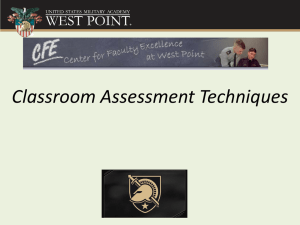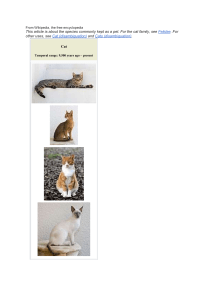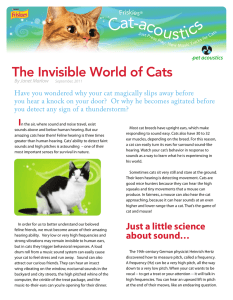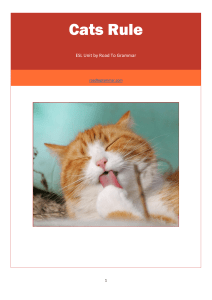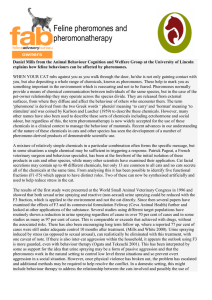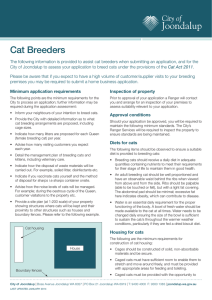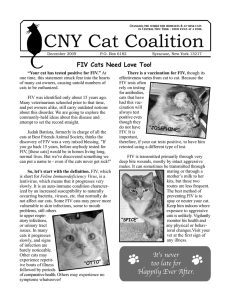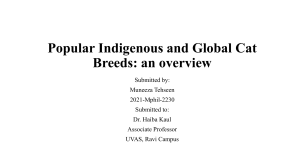Classroom Assessment Tools for Immediate Feedback on Your
advertisement
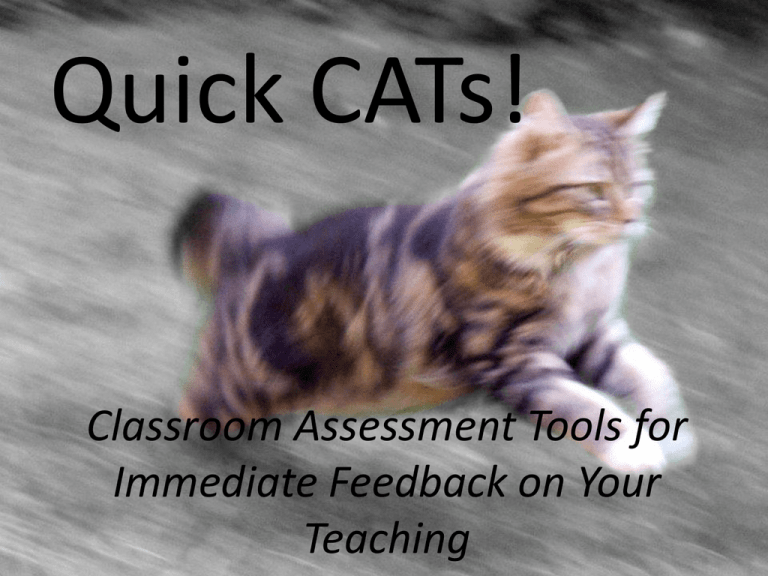
Quick CATs! Classroom Assessment Tools for Immediate Feedback on Your Teaching Overview of CATs • Concepts • Methods • Tools Concepts • Different from Student Course Evaluations and Final Exams • Reduce gap between what was taught and what was learned • Allow time for overcoming gaps well before formal learner assessment • Shift focus from teaching to learning – and from teacher to learner • Purpose is to improve the quality of student learning, not to provide evidence for grading or evaluating students • Most effective time for using CATs is before chapter tests or the midterm and final Benefits for Faculty • Formative, speedy, flexible, anonymous • Day-to-day feedback that can be applied immediately • Useful information about what students have learned without the amount of time required for preparing tests, reading papers, etc. • Surfaces student misconceptions or lack of understanding in a timely way • Fosters good working relationships with students and encourage them to understand that teaching and learning are on-going processes that require full participation Benefits for Students • Greater involvement, reflection and selfassessment • Reduces feelings of isolation and impotence, especially in large classes • Increases understanding and ability to think critically about the course content • Fosters attitude that values understanding and long-term retention • Shows faculty interest and caring about students’ classroom success Teaching Goals Inventory • Online version: http://fm.iowa.uiowa.edu/fmi/xsl/tgi/data_entry.xsl?-db=tgi_data&lay=Layout01&-view • PDF version: http://www.lattc.edu/lattc/staffdev/workshopnotes/drummond/061031/teaching _goals_inventory.pdf Types of CATs (Center for Excellence in Teaching, University of Southern California) • • • • Prior Knowledge, Recall, and Understanding Synthesis and Creative Thinking Application and Performance Analysis and Critical Thinking Course Knowledge and Skills CAT Description Use Background Knowledge Probe Feedback on students' prior learning with short, simple questionnaires prepared by instructors at the beginning of a course (e.g., the instructor requests that students list courses they have already taken in the relevant field), at the start of a new unit or lesson, or prior to introducing an important new topic. Short answers, multiple-choice, or both. Ascertain range of preparation among students in a particular class. Sort into Prepared and Not Prepared. Course Knowledge and Skills CAT Description Use Minute Paper Stop two or three minutes early and ask students to respond briefly in writing to either (1) "What was the most important thing you learned during this class (today)?“ or (2) " What important question remains unanswered?“ Assesses match between instructional goals and students‘ perceptions of these goals and their own learning. Instructor learns what students perceive to be their own learning problems, the likelihood that the students will receive answers to those questions during the next class period is enhanced. The task asks students to evaluate information and to engage in recall. Can be used frequently in courses that present students with large amounts of new information on a regular basis. Tabulate the responses, making note of any especially useful comments. Course Knowledge and Skills CAT Description Use Muddiest Point Ask students to jot down a quick response to the following question: "What was the muddiest point in [the lecture, the homework assignment, the reading, the film, etc.]?" Speedy feedback on what students find least clear or most confusing. Helps faculty decide what to emphasize and how much time to spend on topics. Students must quickly assess what they do not understand and must be able to articulate their confusion (a complex and useful skill). Use frequently in courses that present large amounts of new information, at the end of a session. lecture/ assignment. Synthesis and Creative Thinking CAT Description Use OneSentence Summary Ask students to answer the questions about a given topic: "Who does what to whom, when, where, how, and why?“ Then students are asked to transform their responses into a single, grammatical sentence. Gauges extent to which students can summarize a large amount of information concisely and completely. Answers to each of the initial questions can be assessed separately as "inadequate" (incorrect), "adequate,” and "more than adequate." A matrix with the questions as the columns and the three grading categories as the rows can quickly show whether students are more proficient at the whos and whats rather than the hows and whys. Websites about CATs • Angelo, T. A. & Cross, K. P. (1998). Classroom Assessment Techniques: A Handbook for College Teachers. San Francisco: Jossey-Bass. • Virginia Commonwealth University • Iowa State University • Vanderbilt University • Pennsylvania State University • University of Michigan • North Carolina Institute for Child Development • California State, Long Beach • George Washington University • Indiana University • University of California, Irvine • Rochester Institute of Technology
